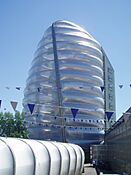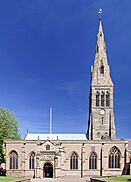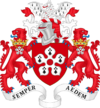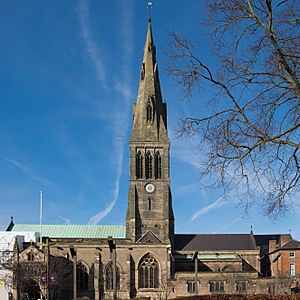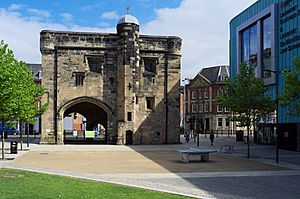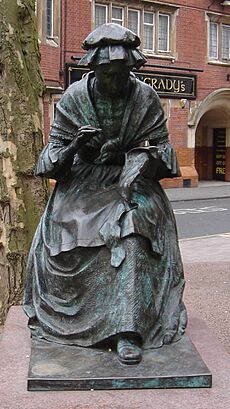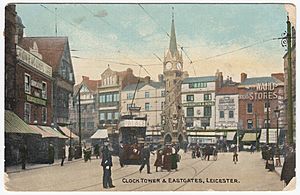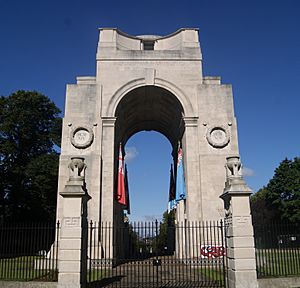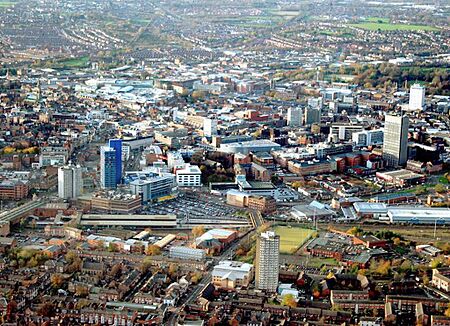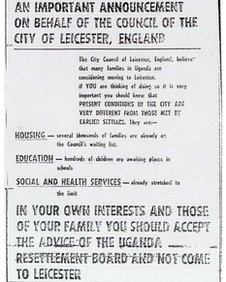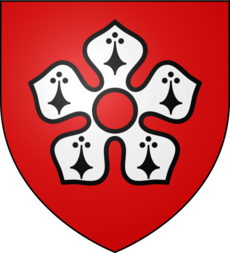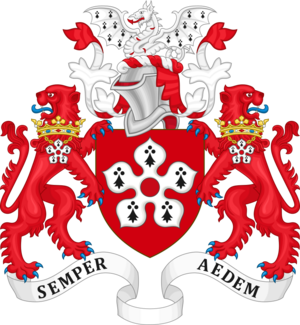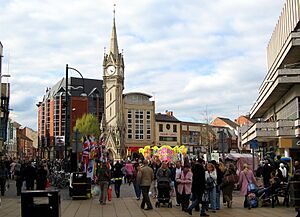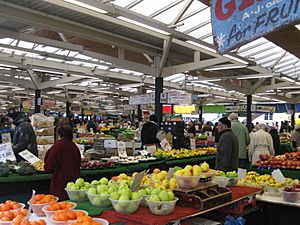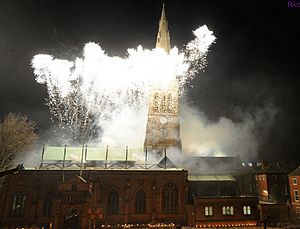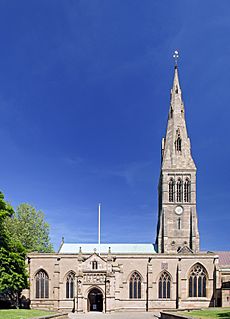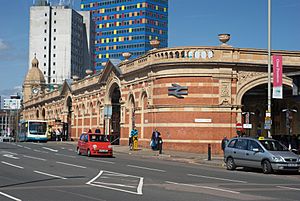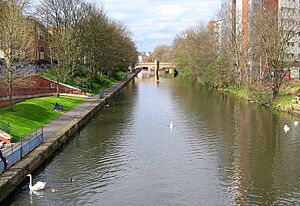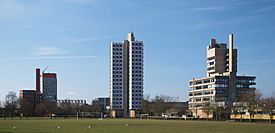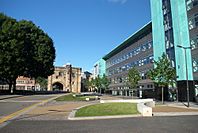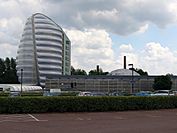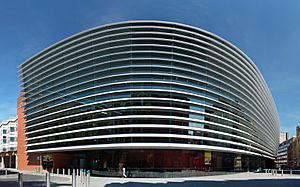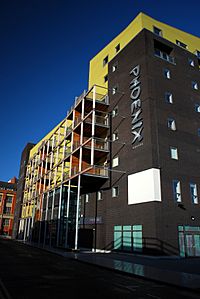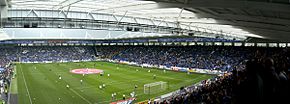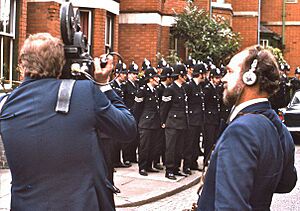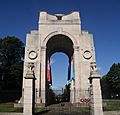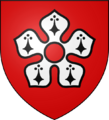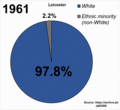Leicester facts for kids
Quick facts for kids
Leicester
|
||
|---|---|---|
|
City and unitary authority
|
||
|
Clockwise, from top: City Centre & Clock Tower; Leicester Cathedral; Curve Theatre; the Jewry Wall; and National Space Centre
|
||
|
||
| Motto(s): | ||
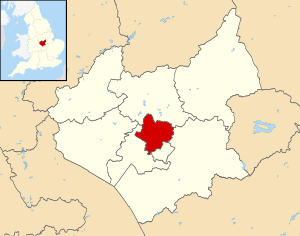
Shown within Leicestershire
|
||
| Sovereign state | United Kingdom | |
| Country | England | |
| Region | East Midlands | |
| Ceremonial county | Leicestershire | |
| Founded | c.47 AD as Ratae Corieltauvorum | |
| City status restored | 1919 | |
| Unitary authority | 1997 | |
| Administrative HQ | City Hall | |
| Civic suite | Leicester Town Hall | |
| Areas of the city (2011 census BUASD) |
List
Abbey
Aylestone Aylestone Park Beaumont Leys Birstall (Village) (part) Braunstone Town (Village) (part) City Centre Clarendon Park Dane Hills Evington Frog Island Glenfield (Village) (part) Glen Parva (Village) (part) Hamilton Humberstone Kirby Muxloe (Village) (part) Knighton (Village) (part) New Humberstone New Parks North Evington Oadby (Town) (part) Rowlatts Hill Rowley Fields South Wigston (Village) (part) Stoneygate Thurncourt Westcotes Wigston (Town) (part) Wolsey Island |
|
| Government | ||
| • Type | Unitary authority with mayor and cabinet | |
| • Body | Leicester City Council | |
| Area | ||
| • Total | 28.32 sq mi (73.34 km2) | |
| Area rank | 251st | |
| Population
(2005 est.)
|
||
| • Total | 354,224 | |
| • Rank | 21st | |
| Demonym(s) | Leicestrian | |
| Ethnicity (2021) | ||
| • Ethnic groups |
List
|
|
| Religion (2021) | ||
| • Religion |
List
24.7% Christianity
23.5% Islam 23.0% no religion 17.9% Hinduism 4.5% Sikhism 0.3% Buddhism 0.1% Judaism 0.6% other 5.6% not stated |
|
| Time zone | UTC+0 (GMT) | |
| • Summer (DST) | UTC+1 (BST) | |
| Postcode area |
LE
|
|
| Dialling code | 0116 | |
| ISO 3166 code | GB-LCE | |
| GSS code | E06000016 | |
| ITL code | TLF21 | |
| GVA | 2021 estimate | |
| • Total | £9.2 billion | |
| • Per capita | £25,124 | |
| GDP (nominal) | 2021 estimate | |
| • Total | £10.2 billion | |
| • Per capita | £27,848 | |
Leicester is a vibrant city in the East Midlands of England. It is the largest city in the region. About 354,224 people live here. The wider urban area has over 559,000 residents. This makes it one of the biggest cities in the UK.
Leicester sits on the River Soar. It is about 90 miles (145 km) northwest of London. The city is also close to other major cities like Birmingham and Nottingham. It is near the eastern edge of the National Forest.
Leicester has a very long and interesting history. It was once a Roman town called Ratae Corieltauvorum. Later, it was taken over by the Anglo-Saxons and then the Vikings. It became an important industrial city in the Victorian age. Leicester officially became a city again in 1919. Since the mid-1900s, many people from the British Commonwealth have moved to Leicester. This has made it a very diverse city.
The city is a major transport hub. It has important railway lines and motorways. Leicester Cathedral is famous for being the burial place of King Richard III. His remains were found nearby in 2012. Leicester is also home to successful sports teams. These include Leicester City (football) and Leicester Tigers (rugby).
Contents
- What's in a Name? The Meaning of Leicester
- A Journey Through Time: Leicester's History
- Leicester's Location and Surroundings
- How Leicester is Governed
- Who Lives in Leicester? A Look at Demographics
- Leicester's Economy: Industries and Shopping
- Landmarks and Attractions in Leicester
- Getting Around: Transport in Leicester
- Learning in Leicester: Schools and Universities
- Faith and Worship: Religions in Leicester
- Culture and Arts in Leicester
- Sports in Leicester: A City of Champions
- Public Services in Leicester
- Local Media: News and Entertainment
- Twin Cities: Leicester's International Friends
- Freedom of the City: Honored Individuals and Groups
- Images for kids
- See also
What's in a Name? The Meaning of Leicester
The name Leicester comes from an old English word. It was first written down in the early 800s. It was called Legorensis civitatis in Latin. In Old English, it was Ligera ceastre.
The first part of the name, Ligore, refers to a group of people. Their name came from the river Ligor, which is now the River Soar. The origin of the river's name is likely from an ancient British language.
The second part, ceaster, is an Old English word. It means "(Roman) fort" or "town." This word came from the Latin word castrum.
Some old texts mention a place called Cair Lerion. People think this might be an early name for Leicester. The Welsh name for Leicester is Caerlŷr.
A writer named Geoffrey of Monmouth wrote about a king called Leir of Britain. He suggested that King Leir founded the city. This story is from the 12th century.
A Journey Through Time: Leicester's History
Leicester is one of England's oldest cities. Its history goes back more than 2,000 years.
Ancient Times: From Iron Age to Roman Rule
Long ago, in the British Iron Age, there was a settlement here. It started around 200 or 100 BC. Not much is known about it. But people lived in roundhouses along the River Soar. The river had two channels then. The settlement likely controlled a place to cross the river.
The name of the Roman town, Ratae, meant "ramparts." This suggests it was a fortified place. The local Celtic tribe was called the "Corieltauvians." They lived in the East Midlands area.
The Romans arrived in Leicester around 47 AD. This was during their conquest of southern Britain. The Corieltauvian settlement was near the Fosse Way. This was a major Roman road connecting Roman army camps.
Around 50 AD, the town grew into the capital of the Corieltauvians. It was called Ratae Corieltauvorum. In the 100s AD, it got a forum (a public square) and a bathhouse. In 2013, a Roman cemetery from 300 AD was found. You can still see parts of the Roman baths at the Jewry Wall. Old Roman items are shown in the museum next to it.
Medieval Leicester: Saxons, Vikings, and Kings
After the Romans left, Leicester was still lived in. But its population was much smaller. The Saxon invasion of Britain led to Leicester being taken over by the Middle Angles. It became part of the kingdom of Mercia.
Leicester became a bishopric (a church area led by a bishop) around 679 AD. But in the 800s, Danish Vikings captured the city. It became one of the Five Burghs of the Danelaw. The Saxon bishop moved away. Leicester did not become a bishopric again until 1927.
After the Norman Conquest, Leicester was called Ledecestre. It was known as a city. But it lost this status in the 1000s due to power struggles. It did not become a legal city again until 1919.
In 1136, Geoffrey of Monmouth wrote about a King Leir. He said King Leir was the founder of the city.
Simon de Montfort became Earl of Leicester in 1231. He made a rule to remove the Jewish population from the city. This was part of a wider trend of persecution. Many Jewish people were forced to leave England in 1290.
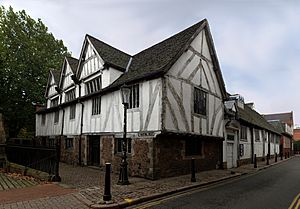
In the 1300s, the Earls of Leicester and Lancaster made the town more important. Henry, 3rd Earl of Lancaster built a hospital for the poor. His son, Henry of Grosmont, made it even bigger. He also built the Church of the Annunciation. This church became a popular place for pilgrimages. It was also the burial place for many important Lancastrian figures.
John of Gaunt died at Leicester Castle in 1399. His son, Henry Bolingbroke, became King Henry IV. Because of this, the titles of Earl of Leicester and Duke of Lancaster became royal titles.
At the end of the War of the Roses, King Richard III was buried in Leicester. He was buried at Greyfriars Church. This church was later torn down. For a long time, people thought his body was lost. But in 2012, archaeologists found a skeleton under a car park. DNA testing confirmed it was King Richard III. In 2015, he was reburied with honor in Leicester Cathedral.
Modern Leicester: From Tudors to Today
Tudor Times and Royal Connections
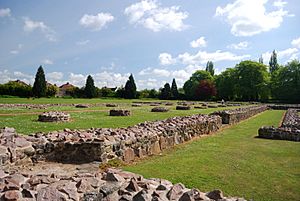
In 1530, Cardinal Thomas Wolsey fell ill while traveling. He stopped at Leicester Abbey and died there. He was buried at the Abbey.
Lady Jane Grey, who was Queen of England for nine days, was born near Leicester. This was around 1536.
Robert Dudley, a close friend of Queen Elizabeth I, was given the title Earl of Leicester.
The Stuart Era and Civil War
In the early 1600s, members of the royal family visited Leicester. This included Anne of Denmark and Prince Charles.
The people of Leicester were against King Charles I's plans to remove trees from Leicester Forest. They worried it would make many people poor. There were riots in 1627 and 1628. People destroyed fences that were put up. The town council tried to stop the changes, but they were not successful.
Leicester was a Parliamentarian stronghold during the English Civil War. In 1645, King Charles I attacked the town. The Royalist army had about 10,000 soldiers. Leicester had only about 2,000 defenders. The town was attacked on May 30, 1645. Hundreds of people were killed. Many houses were destroyed.
After the Parliamentarian victory at the Battle of Naseby, Leicester was taken back by Parliament on June 18, 1645.
The Industrial Revolution and Growth
The Grand Union Canal was built in the 1790s. This connected Leicester to London and Birmingham. The first railway station opened in Leicester in 1832. These transport links helped Leicester grow during the Industrial Revolution.
Factories started to appear, especially along the canal and river. Areas like Frog Island became home to large mills. Between 1861 and 1901, Leicester's population grew a lot. It went from 68,100 to 211,600 people. Many people worked in factories making Hosiery, textiles, and footwear. Companies like N. Corah & Sons became very large.
Leicester was a center for Radicalism. There were Chartist riots in 1842 and 1848. The Leicester Secular Society was founded in 1851. Many new public services were also created. These included the town council and the Royal Infirmary. The city also improved its water supply and sanitation.
Leicester became a county borough in 1889. This meant it had its own local government. It grew by adding nearby areas like Belgrave and Aylestone.
The 20th Century and World Wars
In 1900, another railway line to London opened. But population growth started to slow down. World War I also had a big impact.
In 1919, Leicester was officially recognized as a legal city again. This was because of its help in the war effort. Many factories in Leicester made weapons during the war.
After the war, the city received a royal visit. A memorial arch, the Arch of Remembrance, was built in Victoria Park. It was designed by Sir Edwin Lutyens.
In 1927, St Martin's Church became Leicester Cathedral. This made Leicester a cathedral city again. The city's boundaries were expanded again in 1935 and 1966.
Leicester's economy was diverse. This helped it deal with the economic problems of the 1920s and 1930s. In 1936, Leicester was named the second-richest city in Europe. It became a place where refugees from Europe came to live.
Leicester During World War II
Leicester was bombed on November 19, 1940. Three bombs hit the city. 108 people were killed in Highfields.
Contemporary Leicester: Growth and Diversity
After World War II, Leicester continued to grow. Many new houses and estates were built. The last big development was Beaumont Leys in the 1970s.
Leicester's traditional factories declined. New jobs appeared in the service sector, especially in retail. New shopping centers like the Haymarket and Highcross opened. Leicester's central location and good transport links also made it a distribution center.
Since World War II, many people have moved to Leicester from all over the world. This includes Polish servicemen after the war. People from the Irish Republic also arrived. In the 1960s and 1970s, many immigrants came from the Indian sub-continent. This included Ugandan Asians who were forced to leave Uganda in 1972.
Leicester City Council tried to discourage Ugandan Asians from settling in the city. But this actually made more people aware of Leicester. Many refugees ended up settling there. The mayor of Leicester later expressed regret for the council's actions at that time.
In the 1990s, some Dutch citizens of Somali origin moved to the city. Since 2004, many people from Eastern Europe have also settled in Leicester. This has made Leicester a very multicultural city. Some areas have large South Asian populations. Other areas are mostly white.
The Commission for Racial Equality (CRE) once thought Leicester would be the first UK city without a white British majority. But this prediction was later questioned.
The Leicester Multicultural Advisory Group helps coordinate community relations. It includes people from the council, police, schools, and faith groups.
The COVID-19 pandemic affected Leicester greatly. In July 2020, it had the first local lockdown in the UK. Many shops and businesses had to close again.
Leicester's Location and Surroundings
The Office for National Statistics defines the Leicester Urban Area. This includes the city and nearby towns and villages.
Areas and Neighborhoods
Here are some of Leicester's neighborhoods and suburbs:
- Abbey Rise
- Ashton Green
- Aylestone
- Beaumont Leys
- Bede Island
- Belgrave
- Blackfriars
- Braunstone
- Braunstone Frith
- Bradgate Heights
- City Centre
- Clarendon Park
- Crown Hills
- Dane Hills
- Evington
- Evington Valley
- Eyres Monsell
- Frog Island
- Goodwood
- Hamilton
- Highfields
- Horston Hill
- Humberstone
- Humberstone Garden
- Kirby Frith
- Knighton
- Mowmacre Hill
- Netherhall
- Newfoundpool
- New Parks
- North Evington
- Northfields
- Rowlatts Hill
- Rowley Fields
- Rushey Mead
- Saffron
- Southfields
- South Knighton
- Spinney Hills
- Stocking Farm
- Stoneygate
- St. Matthew's
- St. Mark's
- St. Peters
- Thurnby Lodge
- West End
- West Knighton
- Western Park
- Woodgate
Leicester's Climate: Weather Patterns
Leicester has a maritime climate. This means it has mild to warm summers. Winters are cool. Rain falls throughout the year. There are also low levels of sunshine.
The highest temperature recorded nearby was 34.5°C (94.1°F) in August 1990. The lowest was -16.1°C (3.0°F) in January 1963. On average, it rains about 684.4 mm (26.9 inches) per year.
| Climate data for Newtown Linford, elevation: 119 m (390 ft), 1971–2000 normals, extremes 1960–2002 | |||||||||||||
|---|---|---|---|---|---|---|---|---|---|---|---|---|---|
| Month | Jan | Feb | Mar | Apr | May | Jun | Jul | Aug | Sep | Oct | Nov | Dec | Year |
| Record high °C (°F) | 13.6 (56.5) |
16.3 (61.3) |
21.7 (71.1) |
23.9 (75.0) |
26.5 (79.7) |
31.5 (88.7) |
35.0 (95.0) |
34.5 (94.1) |
27.7 (81.9) |
23.3 (73.9) |
16.2 (61.2) |
14.6 (58.3) |
35.0 (95.0) |
| Mean daily maximum °C (°F) | 6.7 (44.1) |
7.0 (44.6) |
9.9 (49.8) |
12.4 (54.3) |
16.2 (61.2) |
18.8 (65.8) |
21.6 (70.9) |
21.2 (70.2) |
17.8 (64.0) |
13.7 (56.7) |
9.3 (48.7) |
7.5 (45.5) |
13.5 (56.3) |
| Daily mean °C (°F) | 3.6 (38.5) |
3.8 (38.8) |
6.1 (43.0) |
7.9 (46.2) |
11.2 (52.2) |
13.9 (57.0) |
16.2 (61.2) |
16.1 (61.0) |
13.4 (56.1) |
9.9 (49.8) |
6.2 (43.2) |
4.3 (39.7) |
9.4 (48.9) |
| Mean daily minimum °C (°F) | 0.5 (32.9) |
0.5 (32.9) |
2.1 (35.8) |
3.3 (37.9) |
6.0 (42.8) |
8.7 (47.7) |
10.8 (51.4) |
10.7 (51.3) |
8.8 (47.8) |
6.0 (42.8) |
2.8 (37.0) |
1.3 (34.3) |
5.1 (41.2) |
| Record low °C (°F) | −16.1 (3.0) |
−11.7 (10.9) |
−11.1 (12.0) |
−6.6 (20.1) |
−3.3 (26.1) |
−0.9 (30.4) |
2.8 (37.0) |
2.8 (37.0) |
0.0 (32.0) |
−6.2 (20.8) |
−7.4 (18.7) |
−14.4 (6.1) |
−16.1 (3.0) |
| Average precipitation mm (inches) | 61.7 (2.43) |
48.9 (1.93) |
51.9 (2.04) |
51.5 (2.03) |
50.8 (2.00) |
63.1 (2.48) |
46.1 (1.81) |
59.3 (2.33) |
61.5 (2.42) |
60.6 (2.39) |
60.3 (2.37) |
68.8 (2.71) |
684.4 (26.94) |
| Average precipitation days (≥ 1.0 mm) | 12.1 | 10.2 | 11.6 | 9.7 | 9.1 | 9.6 | 7.8 | 8.8 | 9.3 | 10.2 | 10.7 | 11.7 | 120.8 |
| Source: KNMI | |||||||||||||
How Leicester is Governed
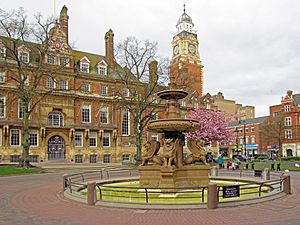
Since 2011, Leicester has had a directly elected Mayor. This person leads the city's government. There is also a Lord Mayor, but this is a ceremonial role. The first mayor of Leicester was Peter fitz Roger in 1251.
On April 1, 1997, Leicester City Council became a unitary authority. This means it is responsible for all local government services. Before this, the city and county councils shared responsibilities. The city council's main offices are at City Hall.
Leicester is divided into 21 electoral wards. These are areas that elect local councillors.
Leicester's Representatives in Parliament
In the 2024 general election, Leicester was divided into three areas for Parliament. These are Leicester East, Leicester South, and Leicester West. Each area elects a Member of Parliament (MP) to represent them in the UK Parliament.
Leicester's Coat of Arms: Symbols of the City
Leicester's coat of arms was first given to the city in 1619. It is based on the arms of Robert Beaumont, the first Earl of Leicester. It shows a white five-leaf shape on a red background.
In 1929, the city council added to the arms. They added lions as supporters. These lions come from the Lancastrian Earls of Leicester.
The city's motto is "Semper Eadem". This means "always the same." It was the motto of Queen Elizabeth I. It suggests that the city is unchanging, reliable, and united. The top of the arms has a white wyvern. This is a dragon-like creature without legs. This special wyvern is a symbol of Leicester.
Who Lives in Leicester? A Look at Demographics
Faith in Leicester (2021) Christian (24.7%) No Religion (23.0%) Muslim (23.5%) Hindu (17.9%) Sikh (4.5%) Buddhist (0.3%) Jewish (0.1%) Other Religions (0.6%) Religion not Stated (5.6%)
In 2011, Leicester's population was 329,839. This was an increase from 279,921 in 2001. The wider urban area had about 509,000 people. Leicester has a slightly larger population than Nottingham.
Leicester has a large proportion of young people. In 2011, 27% of the population was aged 19 or under.
Ethnic Backgrounds in Leicester
According to the 2011 census, Leicester is very diverse.
- 50.6% of the population was White.
- 37.1% were Asian.
- 6.3% were Black.
- 3.5% were of mixed race.
- 1.0% were Arab.
- 1.6% were of other ethnic backgrounds.
Leicester is one of the fastest-growing cities in the UK.
Languages Spoken in Leicester
Leicester is a city of many languages. Besides English, about 70 other languages are spoken.
- Gujarati is spoken by 16% of residents.
- Punjabi is spoken by 3%.
- Somali is spoken by 4%.
- Urdu is spoken by 2%.
Other languages include Hindi and Bengali. New languages from Africa, the Middle East, and Eastern Europe are also becoming common. In some primary schools, English is not the first language for 45% of students.
Population Changes Over Time
| Year | 1901 | 1911 | 1921 | 1931 | 1939 | 1951 | 1961 | 1971 | 2001 | 2011 | 2016 | 2021 | 2026 | 2031 | ||
|---|---|---|---|---|---|---|---|---|---|---|---|---|---|---|---|---|
| Population | 211,579 | 227,222 | 234,143 | 239,169 | 261,339 | 285,181 | 273,470 | 284,208 | 279,921 | 329,839 | 348,343 | 362,500 | 376,000 | 390,000 | ||
| Source: A Vision of Britain through Time | ONS | ONS Projections | ||||||||||||||
Experts predict that Leicester's population will reach 400,000 by around 2035.
Leicester's Economy: Industries and Shopping
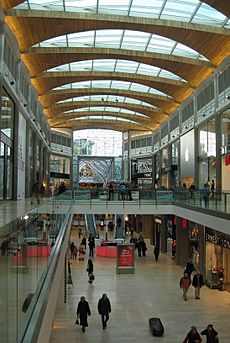
Leicester has the second-largest economy in the East Midlands. Many companies have offices or sites here. These include Dunelm Mill, Next, and Shoe Zone. Other big names are KPMG, HSBC, and British Gas.
Textile Industry in Leicester
Leicester has a long history of making textiles, clothing, and shoes. While some older companies have closed, new ones are active. Companies like Next and Boden still operate here. Some textile makers are even moving back to the city. This is because transport costs from Asia are higher now.
Leicester's garment district has over 1,000 factories. They employ as many as 10,000 workers. There have been concerns about working conditions in this industry. In 2015, research found that many workers were paid less than the legal minimum wage. The Mayor of Leicester is working to improve these standards. He wants to ensure workers are paid fairly and work in safe places.
Engineering in Leicester
Leicester also has many engineering companies. These include Jones & Shipman (machine tools) and Richards Engineering (foundry equipment). Local companies offer apprenticeships for young engineers. Universities in Leicester also have strong links with engineering firms. Leicester was once home to the famous Gents' of Leicester clock manufacturers.
Shopping in Leicester: Malls and Markets
The city center has two large shopping malls. These are Highcross Leicester and the Haymarket Shopping Centre. Highcross Leicester opened in 2008. It has 120 stores, 15 restaurants, and a cinema.
St Martin's Square and the Leicester Lanes area have many unique shops. Leicester Market is the largest outdoor covered market in Europe.
The Golden Mile on Belgrave Road is famous. It has many Indian restaurants, sari shops, and jewelers. Leicester's Diwali celebrations are centered here. They are the largest outside of India.
Food and Drink: Famous Leicester Products
Henry Walker was a successful butcher. He started making crisps in Leicester. In 1971, the Walker's crisps business was sold. Today, Walker's crisps makes 10 million bags of crisps every day. Their factory in Beaumont Leys is the world's largest crisp factory.
Walker's also makes sausages and pork pies. Over three million hot and cold pies are made each week.
Landmarks and Attractions in Leicester
Leicester has many important historical sites. Ten of them are scheduled monuments in Leicester. Thirteen buildings are Grade I listed. This means they are very important historical buildings. Some sites, like Leicester Castle and the Jewry Wall, are on both lists.
Modern Architecture:
- Leicester University Engineering Building
- Kingstone Department Store
- National Space Centre tower
Parks and Green Spaces:
- Abbey Park
- Botanic Gardens
- Castle Gardens
- Grand Union Canal
- Knighton Park
- Nelson Mandela Park
- River Soar
- Victoria Park
- Watermead Country Park
Industrial Heritage and Science:
- Abbey Pumping Station
- National Space Centre
- Great Central Railway
Historic Buildings:
- Town Hall
- Guildhall
- Belgrave Hall
- Jewry Wall
- Secular Hall
- Abbey
- Castle
- St Mary de Castro
- The City Rooms
- Newarke Magazine Gateway
Shopping Areas:
- Abbey Lane
- Beaumont Shopping Centre
- Belvoir Street/Market Street
- Golden Mile
- Haymarket Shopping Centre
- Highcross
- Leicester Lanes
- Leicester Market
- St Martin's Square
- Silver Arcade area
Sports Venues:
- King Power Stadium – home of Leicester City FC (football)
- Welford Road – home of Leicester Tigers (rugby)
- Grace Road – home of Leicestershire County Cricket Club (cricket)
- Paul Chapman & Sons Arena
- Leicester Lions Speedway
- Leicester Sports Arena – home of Leicester Riders (basketball)
- Saffron Lane sports centre – home of Leicester Coritanian Athletics Club
Getting Around: Transport in Leicester
Air Travel: Airports Near Leicester
East Midlands Airport (EMA) is the closest international airport. It is about 20 miles (32 km) northwest of the city. It is a major hub for mail and cargo flights.
Leicester Airport (LRC) is a smaller airport. It is about 6 miles (10 km) east of the city center. It does not have scheduled passenger flights.
Road Network: Motorways and Main Roads
Leicester is located on the M1 motorway. This is a main road connecting London and Leeds. The M1 meets the M69 motorway and A46 here. These roads link to other major routes like the A1 and M6 motorway. Leicester is also connected by other important roads like the A6, A50, A47, and A607.
Bus Services: Public Transport in the City
Leicester has two main bus stations: St. Margarets and Haymarket. Many bus companies operate services in and around Leicester.
There are also three permanent Park and Ride sites. Buses run every 15 minutes from these sites. They help people travel into the city center without their cars.
Leicester has two circular bus services. The Hop! bus goes around the city center. The larger Orbital bus travels around the city's outer areas.
Cycling: Bike-Friendly Leicester
National Cycle Network Route 6 passes through Leicestershire. The Leicester Bike Park is in Town Hall Square.
From 2021 to 2023, Leicester had an electric bicycle sharing scheme. It was called Santander Cycles Leicester.
Railway: Train Connections
Mainline Rail Services
The rail network is very important in Leicester. From Leicester railway station, you can travel to London. The journey to London St Pancras International takes about 1 hour and 25 minutes. From St Pancras, you can connect to international services like Eurostar to Paris and Brussels.
You can also reach other major cities like Sheffield, Leeds, and Birmingham by train.
Great Central Railway: A Historic Line
The old Leicester Central railway station was part of the Great Central Railway. This line used to run from London Marylebone northwards. It closed in the 1960s. However, a preserved section of the line is still open. It runs through central Leicestershire and offers tourist services.
Waterways: Canals and Rivers
Two navigable waterways meet in Leicester. These are the Leicester Line of the Grand Union Canal and the River Soar Navigation. The Grand Union Canal connects Leicester to London and Birmingham. The River Soar links the city to the River Trent in the north.
Learning in Leicester: Schools and Universities
Schools in Leicester
Leicester has many comprehensive schools and independent schools. There are also three sixth form colleges. These colleges used to be grammar schools.
The Leicester City Local Education Authority has worked to improve schools. Many schools have been rebuilt or refurbished.
Tudor Grange Samworth Academy is an academy school. It serves areas like Saffron and Eyres Monsell.
Higher Education: Universities and Space Centre
Leicester is home to two universities:
- The University of Leicester: It became a university in 1957.
- De Montfort University: It started as Leicester Polytechnic in 1969 and became a university in 1992.
The city also has the National Space Centre. This is partly because the University of Leicester specializes in space sciences.
Faith and Worship: Religions in Leicester

Leicester Cathedral is the main Church of England church in the city. It became a cathedral in 1927.
St Nicholas Church is the oldest place of worship in Leicester. Parts of it date back to about 880 AD.
From the mid-1600s, Leicester became a center for Protestant Nonconformity. Many different Protestant groups built churches here. These included Baptists, Congregationalists, Quakers, and Methodists. Many of these churches are still active today. After the 1800s, several Roman Catholic churches and schools were also built.
In 2011, Christians were the largest religious group (32.4%). Muslims were next (18.6%), followed by Hindus (15.2%), and Sikhs (4.4%). Leicester has places of worship for all these faith groups. For example, even though only 0.1% of people are Jewish, the city has two active synagogues.
Places of Worship in Leicester
- Holy Cross Priory (Roman Catholic)
- Shree Jalaram Prarthana Mandal (Hindu temple)
- Stake Centre of the LDS Church
- Four Christadelphian meeting halls
- Jain Centre
- Leicester Cathedral
- Leicester Central Mosque
- Masjid Umar (Mosque)
- Guru Nanak Gurdwara (Sikh)
- Neve Shalom Synagogue (Progressive Jewish)
Culture and Arts in Leicester
Leicester hosts many annual events:
- Caribbean Carnival and parade (one of the largest outside London)
- Diwali celebrations (the largest outside of India)
- The UK's largest comedy festival
- Pride Parade (Leicester Pride)
Belgrave Road is known as "The Golden Mile." It has many jewelers and Indian restaurants.
The Leicester International Short Film Festival is an annual event. It started in 1996. It is one of the most important short film festivals in the UK.
Notable arts venues in the city include:
- Curve: A modern performing arts center, opened in 2008.
- The De Montfort Hall
- The Haymarket Theatre
- The Little Theatre
- The Y Theatre at the YMCA
- The Peepul Centre: A £15 million building with an auditorium, restaurant, gym, and dance studio.
- Phoenix Cinema and Arts Centre: Opened in 2009.
- The Sue Townsend Theatre: Located in the former Phoenix Arts Centre.
Museums in Leicester: Exploring History and Art
-
Newarke Houses Museum (Grade II*)
Music Scene in Leicester
Leicester has a lively music scene. You can find more details about it in the Music in Leicester article.
Sports in Leicester: A City of Champions
Leicester has a very successful history in sports. In 2016, it was even named the UK's Greatest Sporting City. In 2008, it was a European City of Sport.
Leicester Tigers are a very successful English rugby union club. They have won the Premiership title a record eleven times. Their most recent win was in 2022.
Leicester City is a professional football club. They play in the Premier League. The club became famous worldwide when they won the Premier League title in 2016.
Leicester Riders are the oldest professional basketball team in the UK. They moved into a new arena in 2016.
Leicestershire County Cricket Club is a professional cricket club. They play at Grace Road in Leicester. They won the County Championship in 1975, 1996, and 1998.
Greyhound racing used to take place at two venues in the city. The main one was the Leicester Stadium.
Public Services in Leicester
University Hospitals Leicester NHS Trust is a large employer in the city. It has over 12,000 staff. They work in healthcare for the Trust. Leicester City Primary Care Trust also provides healthcare services. Leicestershire Partnership NHS Trust helps with mental health services.
There are also private hospitals like Nuffield Hospital Leicester.
Local Media: News and Entertainment
Print and Online News
The Leicester Mercury newspaper was founded in 1874. It now operates mostly online.
Pukaar Group publishes the Leicester Times. A new independent newspaper, the Great Central Gazette, launched online in 2023.
Television and Radio
Midlands Asian Television (MATV Channel 6) used to broadcast in Leicester.
BBC Radio Leicester was the first BBC Local Radio station in Britain. It opened in 1967. Other local radio stations include:
- Leicester Community Radio
- Demon FM (student radio)
- Takeover Radio (children's radio station)
- Capital Midlands
- Hits Radio East Midlands
- Smooth East Midlands
- Hindu Sanskar Radio (broadcasts during Hindu festivals)
- BBC Asian Network
- Sabras Radio
There are also two hospital radio stations: Radio Fox and Radio Gwendolen. Leicester University has its own station, Galaxy Radio.
Twin Cities: Leicester's International Friends
Leicester is twinned with six cities around the world:
- Strasbourg, France (since 1960)
- Krefeld, Germany (since 1969)
- Masaya, Nicaragua (since 1987)
- Chongqing, China (since 1993)
- Rajkot, India (since 1996)
- Haskovo, Bulgaria (since 2008)
The fire services of Leicester and Krefeld even play an annual football match!
Freedom of the City: Honored Individuals and Groups
The Freedom of the City is a special honor given by Leicester. It is given to important people and military units.
Individuals Honored
- Thomas Wright: 1892
- Edward Wood: 1892
- Thomas Windley: 1903
- Colonel John Edward Sarson: 1903
- Alexander Bains: 1904
- William Wilkins Vincent: 1911
- Thomas Smith: 1918
- Jonathan North: 1919
- Admiral of the Fleet Lord Beatty: 1919
- Thomas Fielding Johnson: 1919
- Field Marshal Lord Haig: 1922
- Charles John Bond: 1925
- Captain Robert Gee: 1925
- James Ramsay MacDonald: 1929
- Lord Laig of Lambeth: 1935
- Walter Ernest Wilford: 1949
- Thomas Rowland Hill: 1956
- Lieutenant Colonel Sir Robert Martin: 1961
- Sir Charles Robert Keene: 1962
- Lord Janner of the City of Leicester: 1971
- Sir Frederick Ernest Oliver: 1971
- Sidney William Bridges: 1971
- Mac Goldsmith: 1971
- Sir David Attenborough: 1989
- Lord Attenborough of Kingston upon Thames: 1989
- Professor Sir Alec Jeffreys: 1992
- Gary Lineker: 1992
- Frank Ephraim May: 2001
- Rosemary Conley: 2001
- Engelbert Humperdinck: 2009
- Susan Lillian Townsend: 2009
- Alan Birchenall: 2009
Military Units Honored
- The Royal Anglian Regiment: 1996
- The 9th/12th Royal Lancers: 2011
Images for kids
-
Shown within Leicestershire
-
The Jewry Wall
-
St Nicholas's Church and the Jewry Wall
-
Leicester Guildhall, dating from the 14th century
-
Leicester Abbey ruins, now part of Abbey Park
-
The Arch of Remembrance in Victoria Park
-
Leicester Town Hall, completed in 1876
-
Highcross Leicester shopping centre
-
University of Leicester seen from Victoria Park – Left to right: the Department of Engineering, the Attenborough Tower, the Charles Wilson Building.
-
Magazine Square, with the Grade I listed Magazine Gateway and the Hugh Aston building of De Montfort University.
-
The interior of Leicester Cathedral
-
Newarke Houses Museum (Grade II*)
-
King Power Stadium, home of Leicester City
See also
 In Spanish: Leicester para niños
In Spanish: Leicester para niños



